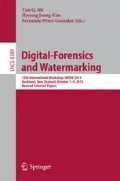Abstract
The adaptive pixel-value differencing (APVD) based steganography proposed by Luo et al. is a state-of-the-art steganographic approach in spatial domain. It can resist blind steganalysis but is vulnerable to the targeted attack proposed by Tan et al. In this paper, we introduce an improved version of APVD. Like APVD, we also first divide an image into some non-overlapping squares and then rotate each of them by a random degree of 0, 90, 180 or 270. For an embedding unit constructed with three consecutive pixels of the resulting image, we randomly select one pixel of it for data embedding. Furthermore, the local statistical features are well preserved by exploiting neighborhood information of pixels. The experimental results evaluated on a large image database reveal that our method makes a significant improvement against the APVD-specific steganalytic attack, and has an impressive performance on resisting blind steganalysis compared with previous PVD-based steganographic methods.
Access this chapter
Tax calculation will be finalised at checkout
Purchases are for personal use only
Notes
- 1.
T is a threshold and has an initialized value of 32 in this work.
- 2.
We set \( k = 4 \) in this paper.
References
Solanki, K., Sarkar, A., Manjunath, B.S.: YASS: yet another steganographic scheme that resists blind steganalysis. In: Furon, T., Cayre, F., Doërr, G., Bas, P. (eds.) IH 2007. LNCS, vol. 4567, pp. 16–31. Springer, Heidelberg (2008)
Luo, W., Huang, F., Huang, J.: A more secure steganography based on adaptive pixel-value differencing scheme. Multimed. Tools Appl. 52, 407–430 (2011)
Li, B., Huang, J., Shi, Y.Q.: Steganalysis of YASS. IEEE Trans. Inf. Forensics Secur. 4(3), 369–382 (2009)
Dumitrescu, S., Wu, X., Wang, Z.: Detection of LSB steganography via sample pair analysis. IEEE Trans. Signal Process. 51(7), 1995–2007 (2003)
Fridrich, J., Goljan, M., Du, R.: Detecting LSB steganography in color and gray-scale images. Magazine of IEEE Multimedia, Special Issue on Security, October–November Issue, pp. 22–28 (2001)
Sallee, P.: Model-based methods for stenography and steganalysis. Int. J. Image Graphics 5(1), 167–190 (2005)
Fridrich, J., Goljan, M., Hogea, D.: Attacking the OutGuess. In: Proceedings of ACM: Special Session on Multimedia Security and Watermarking, Juan-les-Pins, France (2002)
Wu, D.C., Tsai, W.H.: A steganographic method for images by pixel-value differencing. Pattern Recognit. Lett. 24(9–10), 1613–1626 (2003)
Zhang, X., Wang, S.: Vulnerability of pixel-value differencing steganography to histogram analysis and modification for enhanced security. Pattern Recognit. Lett. 25(3), 331–339 (2004)
Wu, H.C., Wu, N.I., Tsai, C.S., Hwang, M.S.: Image steganographic scheme based on pixel-value differencing and LSB replacement methods. Proc. Inst. Elect. Eng., Vis. Images Signal Process. 152(5), 611–615 (2005)
Chan, C.K., Chen, L.M.: Hiding data in images by simple LSB substitution. Pattern Recognit. Lett. 37(3), 469–474 (2004)
Yang, C.-H., Weng, C.-Y., Wang, S.-J., Sun, H.-M.: Adaptive data hiding in edge areas of images with spatial LSB domain systems. IEEE Trans. Inf. Forensics Secur. 3(3), 488–497 (2008)
Tan, S., Li, B.: Targeted steganalysis of adaptive pixel-value differencing steganography. In: 2012 19th IEEE International Conference on Image Processing (ICIP), 30 September 2012–3 October 2012, pp. 1129–1132 (2012)
Bas, P., Filler, T., Pevný, T.: “Break our steganographic system”: the ins and outs of organizing BOSS. In: Filler, T., Pevný, T., Craver, S., Ker, A. (eds.) IH 2011. LNCS, vol. 6958, pp. 59–70. Springer, Heidelberg (2011)
Fawcett, T.: An introduction to ROC analysis. Pattern Recognit. Lett. 27(8), 861–874 (2006)
Ker, A.D., Böhme, R.: Revisiting weighted stego-image steganalysis. In: Delp, E.J., Wong, P.W. (eds.) Proceedings SPIE, Electronic Imaging, Security, Forensics, Steganography, and Watermarking of Multimedia Contents X, San Jose, CA, 27–31 January 2008, vol. 6819, pp. 51–517 (2008)
Pevny, T., Bas, P., Fridrich, J.: Steganalysis by subtractive pixel adjacency matrix. In: Proceedings of the 11th ACM Multimedia and Security Workshop, Princeton, NJ, 7–8 September 2009, pp. 75–84 (2009)
Acknowledgement
This work was supported by the NSF of Beijing under 4112063, the NSF of China under 61170281 and 61303259, the Strategic Priority Research Program of the Chinese Academy of Sciences under XDA06030601, and the IIE’s Research Project on Cryptography under Y3Z0012102.
Author information
Authors and Affiliations
Corresponding author
Editor information
Editors and Affiliations
Appendix
Appendix
The appendix will show how to derive the range of the modified pixel in an embedding unit so that the secret message can be embedded and extracted properly.
Without loss of generality, consider Case 3.2 of Step 3 in data embedding. That is to say, given the condition that |d 1| > T, |d 2| > T, p i+3 ≤ p i+1, p i+3 < p i+2, so p i+3 is supposed to be modified according to the embedding algorithm and denote the modified p i+3 as \( p_{i + 3}^{'} \). The goal is to derive the range of \( p_{i + 3}^{'} \), a new pixel value of which is able to preserve the inequations as follows:
Consequently, the range of \( p_{i + 3}^{'} \), denoted by \( range_{{p_{i + 3}^{'} }} \), can be finally derived as
Notice that the range of the modified pixel depends on at least one of the two others which keep their own pixel values unchanged. When the same embedding unit is dealt with during data extraction, the receiver will depend on those inequations which can reappear to ensure the secret message extracted properly.
Other cases of Step 3 in data embedding can be considered in a similar way.
Rights and permissions
Copyright information
© 2014 Springer-Verlag Berlin Heidelberg
About this paper
Cite this paper
Zhang, H., Guan, Q., Zhao, X. (2014). Steganography Based on Adaptive Pixel-Value Differencing Scheme Revisited. In: Shi, Y., Kim, HJ., Pérez-González, F. (eds) Digital-Forensics and Watermarking. IWDW 2013. Lecture Notes in Computer Science(), vol 8389. Springer, Berlin, Heidelberg. https://doi.org/10.1007/978-3-662-43886-2_3
Download citation
DOI: https://doi.org/10.1007/978-3-662-43886-2_3
Published:
Publisher Name: Springer, Berlin, Heidelberg
Print ISBN: 978-3-662-43885-5
Online ISBN: 978-3-662-43886-2
eBook Packages: Computer ScienceComputer Science (R0)

